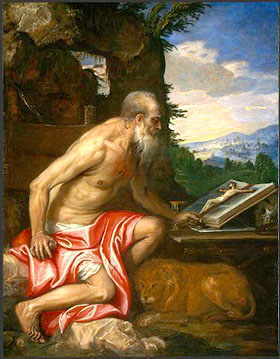....was above all a Scripture scholar, translating most of the Old Testament from the Hebrew. He also wrote commentaries ... He was an avid student, a thorough scholar, a prodigious letter-writer and a consultant to monk, bishop, and pope. Saint Augustine said of him, “What Jerome is ignorant of, no mortal has ever known.”
.....In order to be able to do ...work [like translating the Bible], Jerome prepared himself well. He was a master of Latin, Greek, Hebrew, and Chaldaic. He began his studies at his birthplace, Stridon in Dalmatia. After his preliminary education, he went to Rome, the center of learning at that time, and thence to Trier, Germany, where the scholar was very much in evidence. He spent several years in each place, always trying to find the very best teachers. He once served as private secretary of Pope Damasus.
After these preparatory studies, he traveled extensively in Palestine, marking each spot of Christ’s life with an outpouring of devotion. Mystic that he was, he spent five years in the desert of Chalcis so that he might give himself up to prayer, penance, and study. Finally, he settled in Bethlehem, where he lived in the cave believed to have been the birthplace of Christ. Jerome died in Bethlehem, and the remains of his body now lie buried in the Basilica of St. Mary Major in Rome.
We found this portrayal of St. Jerome:
.....In order to be able to do ...work [like translating the Bible], Jerome prepared himself well. He was a master of Latin, Greek, Hebrew, and Chaldaic. He began his studies at his birthplace, Stridon in Dalmatia. After his preliminary education, he went to Rome, the center of learning at that time, and thence to Trier, Germany, where the scholar was very much in evidence. He spent several years in each place, always trying to find the very best teachers. He once served as private secretary of Pope Damasus.
After these preparatory studies, he traveled extensively in Palestine, marking each spot of Christ’s life with an outpouring of devotion. Mystic that he was, he spent five years in the desert of Chalcis so that he might give himself up to prayer, penance, and study. Finally, he settled in Bethlehem, where he lived in the cave believed to have been the birthplace of Christ. Jerome died in Bethlehem, and the remains of his body now lie buried in the Basilica of St. Mary Major in Rome.
We found this portrayal of St. Jerome:

Notice the lion, associated with Jerome in many pictures.
From this last source we also learn Jerome is the patron saint of archeologists, and translators and librarians.
No comments:
Post a Comment